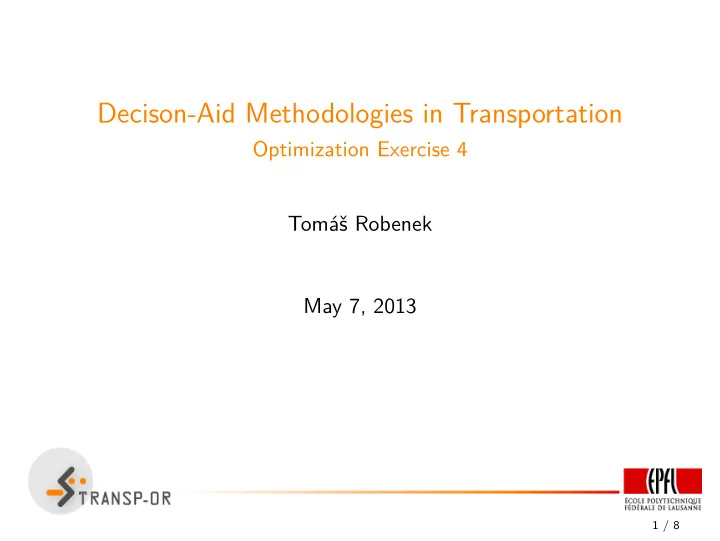

Decison-Aid Methodologies in Transportation Optimization Exercise 4 Tomáš Robenek May 7, 2013 1 / 8
Aircraft Rotation/Fleet Assignment Problem – Input 2 / 8
Aircraft Rotation Problem – Output Leg to base Base to Leg LHR flow ARN flow OSL flow CPH flow HEL flow 3 / 8
Model I F – set of flight legs to be covered – set of fleet types K M k – number of available aircraft of type k c k – operating cost minus the revenue of aircraft type k to flight leg i i N k – set of nodes in the time-space network of aircraft type k G k – set of ground nodes in the time-space network of aircraft type k O ( k , n ) – set of flight legs originating at node n in fleet k ’s time-space network I ( k , n ) – set of flight legs terminating at node n in fleet k ’s time-space network n + – ground arc originating in node n n − – ground arc terminating in node n CL ( k ) – set of flight legs of fleet k CG ( k ) – set of ground arcs of fleet k � 1 if and only if flight leg i is to be operated with an aircraft type k , f k = i 0 otherwise. y k – number of aircraft type k on the ground arc a a 4 / 8
Model II � � c k i · f k max (1) i i ∈ F k ∈ K � f k s.t. i = 1 , ∀ i ∈ I , k ∈ K (2) y k � f k i − y k � f k ∀ n ∈ N k , ∀ k ∈ K , n + + n − − i = 0 , i ∈ O ( k , n ) i ∈ I ( k , n ) (3) � y k � f k i ≤ M k , a + ∀ k ∈ K , a ∈ CG ( k ) i ∈ CL ( k ) (4) f k i ∈ { 0 , 1 } , ∀ i ∈ F , ∀ k ∈ K (5) y k ∀ a ∈ G k , ∀ k ∈ K . a ≥ 0 , (6) 5 / 8
• this is the basic model, your model will have more constraints • we don’t have limit on the fleet size (we don’t need variable y), but since there is a pullout cost and operating cost, the minimization function will minimize the fleet size • be careful on what are the decision variables! • to calculate the fare profit of the leg, use minl(value1, value2) function • constraints to cover: – start/end in the base – come back to the same base, that the plane left – 2 legs can be connected only when the airport is the same – turnaround constraint – all legs covered – flow conservation 6 / 8
• how to use arc representations in OPL: • tuple ArcLeg{ int start; int end; } • forall(i in Legs) sum(a in Arcs, b in Bases: a.end==i)... 7 / 8
References L. Clarke, E. Johnson, G. Nemhauser, and Z. Zhu, The Aircraft Rotation Problem , Annals of Operations Research 69 (1997), 33–46. Lloyd Clarke, Ellis Johnson, George Nemhauser, and Zhongxi Zhu, The aircraft rotation problem , Annals of Operations Research 69 (1997), no. 0, 33–46 (English). 8 / 8
Recommend
More recommend